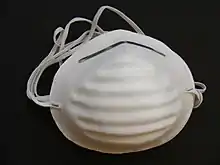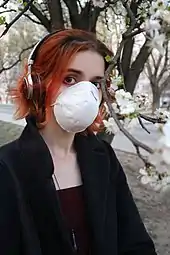Dust mask
A dust mask is a flexible paper pad held over the nose and mouth by elastic or rubber straps for personal comfort against non-toxic nuisance dusts. They are not intended to provide protection from toxic airborne hazards.[1][2] The European FFP1 mask, the lowest-grade mechanical filter respirator available in the jurisdiction, is also used as a dust mask.


Dust masks are used in environments with dusts encountered during construction or cleaning activities, such as dusts from drywall, brick, wood, fiberglass, silica (from ceramic or glass production), or sweeping. A dust mask can also be worn in environments with allergens such as tree and grass pollen. A dust mask is also used to prevent the wearer from inhaling dust or sand in a dust storm or black blizzard.
Description
A dust mask is worn in the same fashion as a filtering facepiece respirator or surgical mask, but it is dangerous to confuse them because they each protect against specific airborne dangers. Using the wrong mask for a job can present a significant and possibly deadly danger as many dust masks with widely varied levels of protection may look similar, and even masks that do not protect against dust at all. Misfitting masks are also a danger as they allow a material to bypass the mask entirely. A correct fit may not be as critical in masks that are intended to protect against splattering liquids or mists. Dust masks do not protect against chemicals such as vapors and mists. For this reason, it is dangerous to confuse dust masks with respirators used as paint masks.
Dust masks are a cheaper, lighter, and possibly more comfortable alternative to respirators, but do not provide certified respiratory protection, and may be more susceptible to misuse or poor fit.
Some dust masks include improvements such as having two straps behind the head (one upper and one lower), having a strip of aluminum on the outside across the bridge of the nose that can be bent for a custom fit, and having a strip of foam rubber on the inside across the bridge of the nose to ensure a better seal even if the aluminum on the outside does not fit.
Regulation
Some Asian countries have regulations for dust-grade masks intended for everyday civilian use as opposed to occupational use. These include:
- China, GB/T 32610:2016 – masks for daily protection
Dust masks[3] have been certified by the United States Bureau of Mines since the 1930s.[4] Since 1970, the Occupational Safety and Health Administration approves dust masks, called a "filtering facepiece" in NIOSH jargon.[5] Filtering facepiece are considered a type of respirators, and an N95 mask is a filtering facepiece too.[6]
See also
References
- "Do you know the difference between a dust mask and a respirator?" (PDF). University of Alabama at Birmingham. 2016-10-28. Retrieved 2020-03-28.
- "Dust Mask vs. Respirator". Michigan State University. Retrieved 2020-03-29.
- N. Irving Sax, ed. (1957), "Personnel protection and personal hygiene", Dangerous Properties of Industrial Materials, p. 58
- "History of U.S. Respirator Approval (Continued) Particulate Respirators", J Int Soc Respir Prot, 2019, PMID 32572305
- NIOSH-Approved Particulate Filtering Facepiece Respirators
- "Numerous questions on filtering facepiece/dusk mask respirators". Occupational Safety and Health Administration.